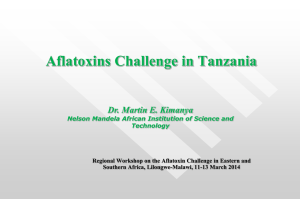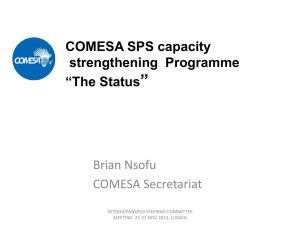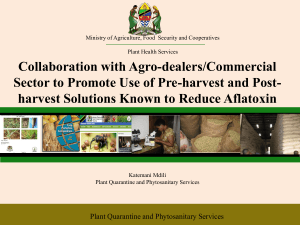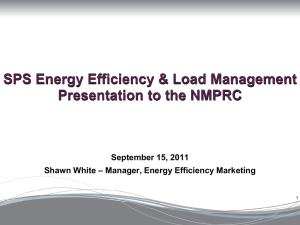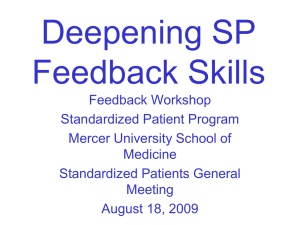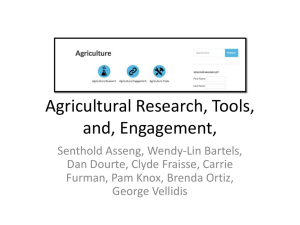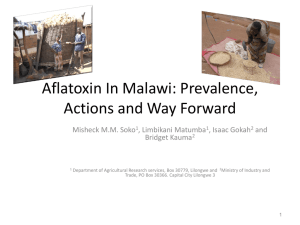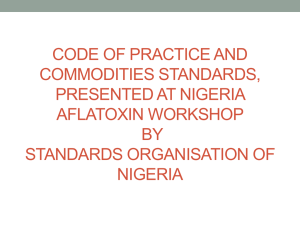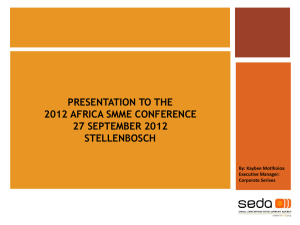COMESA- Aflatoxin Meeting
advertisement
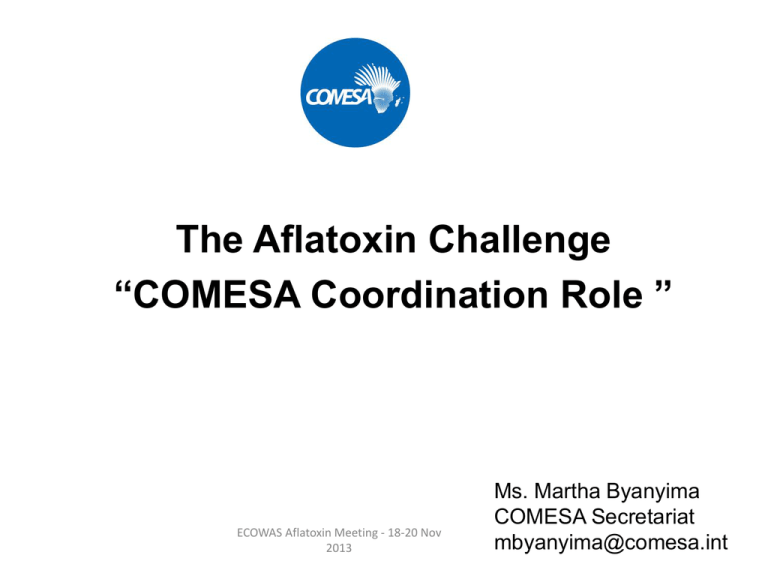
The Aflatoxin Challenge “COMESA Coordination Role ” ECOWAS Aflatoxin Meeting - 18-20 Nov 2013 Ms. Martha Byanyima COMESA Secretariat mbyanyima@comesa.int Overview • The Mycotoxin/aflatoxin challenge in COMESA – Challenges in regional and international trade • Role of COMESA (coordination, setting priorities) – – – – – The MTSP and the SPS Logical Framework The SPS Unit (Secretariat) The SPS sub Committee (Member States) The Tripartite SPS /TBT capacity building programme Success stories • Linkages with PACA – The PACA strategic Plan – The COMESA Aflatoxin Meeting (2014) ; sharing experiences with governments, industry and partners (Nacala corridor) • Conclusions ECOWAS Aflatoxin Meeting - 18-20 Nov 2013 Mycotoxins/aflatoxins challenge in COMESA • Capacity challenges in the public and private sector, particularly SMEs • Inadequate legislation & institutional framework • Varied sampling and testing protocols ( scientific data for establishing FSO and negotiating equivalence) • Varied laboratory competencies, rejection of certificates of analysis • The result in mistrust and restrictions on trade in aflatoxin sensitive foods • Maize, peanuts, cassava, and value added products e.g. peanut butter, cassava flour etc ECOWAS Aflatoxin Meeting - 18-20 Nov 2013 Challenges in international trade EU 178/2002 – (a) places legal obligations on food operators (producers, food & feed processors) to ensure food safety, to review and control critical control points for mycotoxin contamination (systems), supplemented by; (b) maximum limits for mycotoxins in food stuffs Reg 165/2010, total aflatoxin from 4 to 8 ppb for ready to eat, 10-12 ppb for further processing, aflatoxin M1/ 0.05 ppb, (c) OC methods for sampling and analysis of mycotoxins Reg 178/2010 ECOWAS Aflatoxin Meeting - 18-20 Nov 2013 COUNTRY Total Aflatoxins COMMENTS Republic of South Africa 10 - 15 ppb Cereals, peanuts, other nuts Zambia 10 ppb Cereals, peanuts, other nuts Malawi 5 ppb Cereals, peanuts, other nuts Zimbabwe 5 ppb Cereals, peanuts, other nuts Kenya 10 ppb Cereals, peanuts, other nuts Egypt 10 ppb Cereals, peanuts, ECOWAS Aflatoxin Meeting - 18-20 Nov other nuts 2013 Background – MTSP & SPS LF MTSP priorities: (a) removing barriers to trade to consolidate the internal market/FTA (b) building productive capacity to enhance global competitiveness and build regional capacity The MTSP guides the outcomes, The SPS LF guides intervention logic (what &how) The SPS Legal Framework • SPS Unit • SPS sub committee -for coordination, decision making/setting priorities ECOWAS Aflatoxin Meeting - 18-20 Nov 2013 The SPS Logical Framework Result Areas 1. Regional leadership, coordination and collaboration 2. Private-sector-driven common certification schemes/protocols and standards in use 3. Monitoring, surveillance, diagnostic and emergency response systems for priority SPS risks 4. Improved decision making using accurate and up-todate SPS information 1. Reinforce partnerships: AU, USAID, USDA, STDF, CABI/Africa, JIFSAN, IITA, AATF,TMSA/DFID, AFDB, partner RECs 1.1 NTB reporting system 1.2 Technical Meetings of the SPS sub committee (annual) 2.1 SPS trade facilitation research, pilots, bilateral agreements on import protocols 3.1 Fruit fly surveillance, plant pests/diseases 3.2 aflatoxin sampling and testing protocols – MR mechanism 3.3 Pest Risk Analysis 4.1 MCDA in Uganda, Ethiopia, Malawi, Zambia and Rwanda Kenya, Zimbabwe are next 4.2 MCDA at regional level CAADP Pillar 2 (Market access & trade capacities) Objective – framework to prioritize Market access and trade related Investments in the Agric sector Principle – All inclusive, Includes non state actors, PS Process steps (i) Stocktaking, review of sector to establish status with respect to CAADP targets, investment gaps (ii) Analysis - prioritizing and costing the growth options focusing on the best returns. (iii) Investment Plan - integrated investment / operational plan MCDA (Market access) Objective – framework to prioritize SPS capacity building options with a trade outcome Principle - must engage private sector and key stakeholder Process steps (i) Gathering information, preparing information dossier based on which to establish capacity building options to be considered in the priority setting process . (ii) Analysis – costing and ranking the prioritized capacity building options (iii) SPS capacity building options integrated in the CAADP Investment Plan The Tripartite SPS work programme (EAC-COMESA-SADC) Quote: “The tripartite arrangement is the most exciting trade and infrastructure development in Africa at the moment, it provides the foundation of the Continental Free Trade Area promoted by the AUC and its partners “ • Market integration pillar – (i) a functional FTA free from NTBs, SPS measures inclusive. • Article 25 of the Tripartite FTA Agreement and Annex 10 on SPS; Key provisions/policy instruments and an implementation structure • Joint EAC-COMESA-SADC capacity building programme to pilot best practices and approaches along key trade is ongoing to inform interventions • STDF/DFID/COMESA research on SPS and trade ECOWAS Aflatoxin Meeting - 18-20 Nov 2013 facilitation Success Story – public/private partnership for harmonizing phytosanitary import requirements Key activities PRA Industry mitigation through GAPs and Food Safety Measures Dairy, fisheries Identified for action ECOWAS Aflatoxin Meeting - 18-20 Nov 2013 Factories that are HACCP Compliant Success story: the pelagic fish industry (Dagaa/Kenya, Kapenta/Zambia, Mukene/Uganda) 10 Years ago Poor harvesting methods Inadequate food safety standards Poor handling practices ECOWAS Aflatoxin Meeting - 18-20 Nov 2013 Today : Modern harvesting technology Improved handling and drying Improved food safety standards Success story : Domestic and Regional Markets expanding thru food safety/quality management and Value addition Conclusions • Effective coordination mechanism at tripartite level (EACCOMESA-SADC) • Legally binding decisions • Tripartite structure to enable harmonization, equivalence and mutual recognition • Tripartite structure to enable effective capacity building including regulatory reforms • Partners on board include DFID, AFDB, STDF and partners • Challenge is aligning partners with regional/tripartite integration priorities • How does PACA or GFSI support the tripartite agenda ? • Are there lessons for ECOWAS and other RECs ? ECOWAS Aflatoxin Meeting - 18-20 Nov 2013
